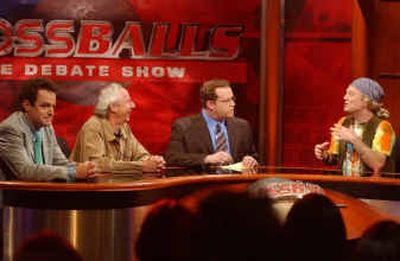Real and fake

Pity Corey Williams. The actor is on a contentious talk show, sparring with a guy who practices for reality TV by eating cow patties, another who’s begging to get on air — and a professor who thinks The Next Big Show is a “real-life Hogan’s Heroes” set in a concentration camp run by neo-Nazis.
But while Williams believes he’s debating real people, he’s actually been ensnared in an elaborate web of deceit and in-your-face rhetoric — as if Bill O’Reilly had done “Candid Camera.” In the genre-bending and often hilarious “Crossballs,” which premieres tonight at 7:30 for an eight-week run on Comedy Central, the real is the fake, the fake is the real — and nobody knows which end is up.
“Crossballs” hovers on the razor edge of plausibility (and, this being cable, body-function crudeness).
Its talk-show format — “Out of the ‘Crossfire.’ Beyond ‘Hardball,’ ” as the announcer intones — pits real guests recruited to debate real issues against improv actors portraying other “real” guests with audacious, often obnoxious opinions.
The shows end without the con being revealed to the dupes, and a little nagging doubt remains — even for viewers.
Consider the episode on whether reality TV is a pursuit worthy of humanity. On one side you have Williams, the actor, brought on to defend his craft.
“How much talent does it take to hang upside-down with a cow patty in your mouth?” Williams snaps.
On the other side is hard-core reality-TV vet Matthew Henson (played by Matt Besser), sporting a sleeveless, skull-festooned shirt and insisting that all professional actors are liars.
“I’m not going to put words in your mouth,” he tells Williams. “You let scripts do that for you.”
Besser, the executive producer and one of those who dreamed up the idea, steals the show. His entirely un-PC characters (including the owner of the “Ozark Mountain Driving School”) exhibit a simplicity and regular-guy tendentiousness that is exactly the Middle America stereotype so feared by those on the coasts.
“Ever since 9/11, America’s kind of changed. People, they’re sick of the phonies in the world. They’re sick of liars,” Besser says to Williams. Under him appears the classic one-line TV identifier: “MATTHEW HENSON — REALITY TV BUGEATER.”
(The superimposed text is one of the show’s funniest characteristics, riffing off the weird things people say. Among them: ” ‘Wizard of Oz’ midget orgies?” “Knowing in advance: Ruins surprise?” And the classic “Bilingual Drivers: Dangerous or peligroso?”)
Host Chris Tallman — with an appealing combination of John Goodman’s bluster and Albert Brooks’ manic disbelief in the world around him — acts as the linchpin, moderating between his fake guests and the real ones and making sure no one can elaborate too much on an idea.
Among the impostors who make appearances:
• Jerry Wilson (Jerry Minor), self-described “bartender and taxi driver,” who is offended that the police have impeded his moonlighting by preventing him from driving while intoxicated. “The problem is, people don’t know how to drink and drive,” he says.
• Activist Mary Glenn (Mary Birdsong) of “Mothers vs. Advanced Age Drivers (she pronounces it “maaaaaaaaaaaad”), who insists that major restrictions should be slapped on drivers over 55 and that their tires should be slashed, if necessary, for their own good. Cut to the outrage on the face of Kai Hernandez, apparently a real-life advocate for elderly drivers.
• Andy Conroy (Andy Daly), a speech-impeded reality TV wannabe who has prepared a clip reel that depicts him setting traps for himself so he can be surprised — and promises he can forget all the humiliation so he can be surprised anew on a reality show.
“I want to be tricked,” he says, smiling a beatific, moronic smile. (You can’t stop staring at his green-brown striped V-neck sweater, which is clearly acrylic.)
The social pressures of respect are fascinating to watch. The dupes are hesitant to be dismissive even as the remarks they field become more and more unbelievable.
When it’s over, though, you’re left wondering: Are the “actual people” legit? Or are they just another layer in the fabric of fakery?
“Is this guy for real?” Williams, the actor, says at one point.
It’s a more valid question than even he realizes.
Contained in the nonsense of comedy is the absurdity of the “reality” that we’re dealing with daily on television, and that’s no small matter these days.
In the end, the improv actors and the real people collaborate to serve two major purposes: Keep the arguments going and keep people interrupting each other, no matter the premise. And these days, how is that so different from real life?